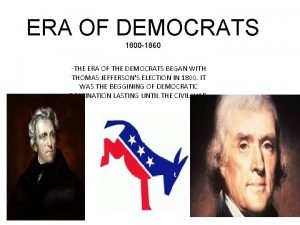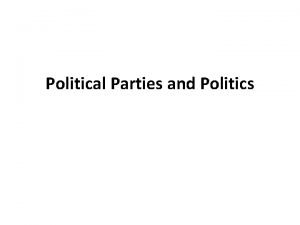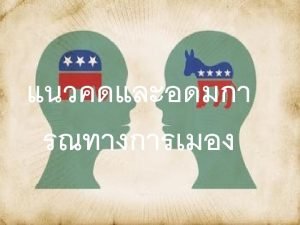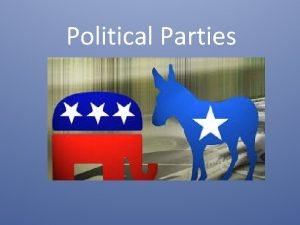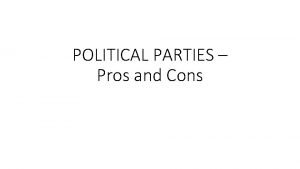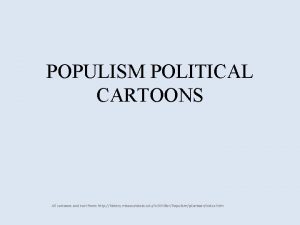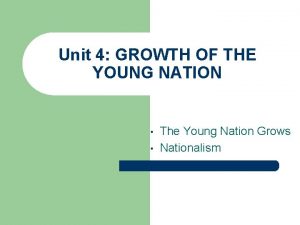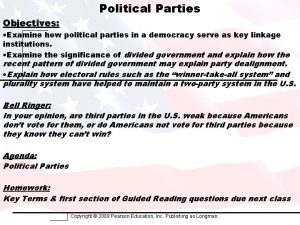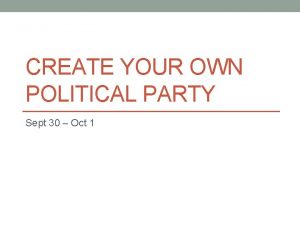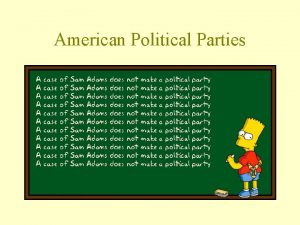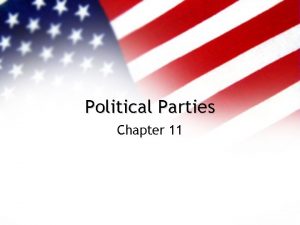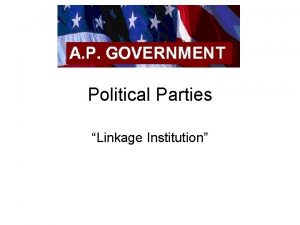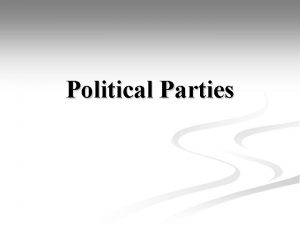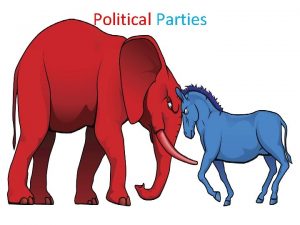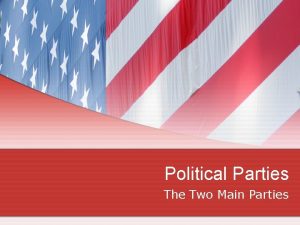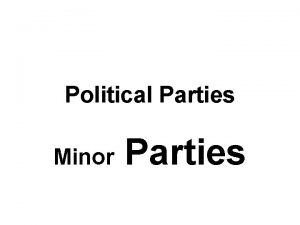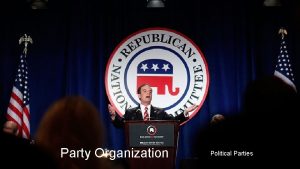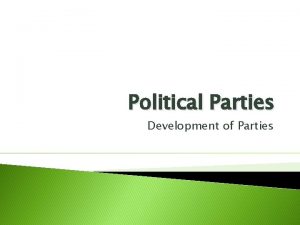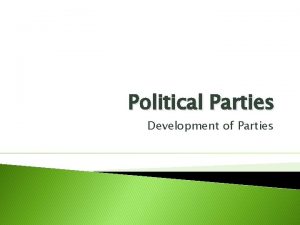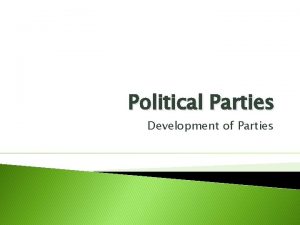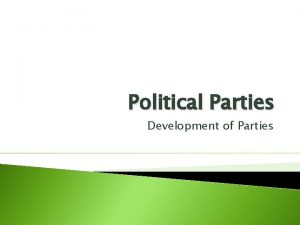Political Parties Whig Party Political Party Systems n
















- Slides: 16

Political Parties Whig Party

Political Party Systems n 3 Political Party Systems in the World 1. ) One Party System: Political party and the government are the SAME § Only 1 party, so no competing ideas § Party membership based on lineage, wealth, military power, religious power § Example: China (Communist Party)

Political Party Systems 2. ) Multi-Party System: Three or more parties compete for control of the government – Common in Europe, Israel, Japan – Advantage: provides voters with many different choices and ideas – Disadvantage: difficult for one party to get majority of votes, which leads to a Coalition: EXAMPLE – Italy (50 different govts. since WWII) Daisy Alliance 500, 000 votes Sunflower Alliance 450, 000 votes Coalition Italian Communist 200, 000 votes

Political Party Systems 3. Two-Party System: Two parties compete with each other to run the government. – Party system of U. S. : Democrats and Republicans – Advantages: Continuity – Disadvantages: Minority parties (third parties) receive little attention – focus is on two main parties

U. S. Political Parties: Characteristics n Democratic Party – Tends to Attract ØWorking people (blue collar) ØLiberals ØCatholics ØMinorities ØUnion Members ØPeople in favor of govt. involvement in social policies n Republican Party – Tends to attract ØBusinesspeople (white collar) ØProtestants ØConservatives ØNon-minorities ØNon-union supporters ØPeople against govt. involvement in social policies

The Issues: Abortion n Democrats: – Pro Choice – Favors contraceptive education to prevent necessity of abortion n Republicans: – Pro-life; Anti-Choice – Prefers funding go towards marriage education and abstinence only campaigns – Have tried several times to pass statutes that would allow prosecution of acts that harm fetuses

Democrats The Issues: Environment n Democrats n – Support stronger environmental laws and protection of nature – Push for cleaner air and water – Support funding for preservation (Everglades in FL; Redwoods in CA, etc…) Republicans: – Favor the exploration of all resources in the U. S. for energy production and have generally opposed looking for more environment-friendly power alternatives – Pushed for oil drilling in ANWR, the building of more nuclear power plants, a shift towards the use of coal, and have submitted proposals that would weaken the Clean Air Act

Democrats: The Issues: Gay Rights n Democrats: – Should be protected from workplace discrimination and hate crimes – Should be given equal work benefits like more traditional families – Largely oppose President Bush’s proposal to ban gay marriage through a Constitutional Amendment n Republicans: – Against giving gays equal rights in the eyes of the law – “We do not believe sexual preference should be given special legal protection or standing in law” – Oppose idea of gay marriage; seek to define marriage as union between man and woman – Supports amendment to the Constitution defining marriage

The Issues: Gun Control n Democrats: – Strong advocates for gun control – Supported both the Brady Bill and the Assault Weapons Ban n Republicans: – Favors allowing the sale of firearms to proceed more easily, and with fewer safety precautions – Opposes any new guncontrol laws – Fought the regulation and banning of assault weapons

The Issues: Health Care n Democrats: – Push for more Heath Care funding (Medicare, Children’s Health Insurance Program) – In favor of program to ensure all Americans have quality, affordable health care. (100% government funded) n Republicans: – Believes health care should work within the free market system where competition will lower the costs of healthcare (no federal govt. involvement)

The Issues: Foreign Policy n Democrats: – Generally much more supportive of international agencies than are Republicans – support NATO and the UN – More skeptical of the Bush Administration’s rush to war than were the Republicans – Very skeptical of the handling of the reconstruction of Iraq n Republicans: – Have brushed aside international organizations in favor of unilateral policy of preemption – Bush Doctrine supports preemptive invasion when necessary to protect the security of the U. S. – Argue that the use of American military force is essential for keeping the world safe for Democracy

The Issues: Education n Democrats: – More funding for struggling schools is necessary – Highly critical of No Child Left Behind, which has been under funded – Tax money should not be used on religious schools n Republicans: – Support both the “No Child Left Behind” program and the school vouchers – Favor school vouchers because they think that by giving students more educational options, including religious schooling, a competitive market will be created § Argue public schools will be forced to improve in order to retain students

The Issues: Social Security n Democrats: – Fundamental right of Americans – Best way to protect is to maintain federal government control – Largely oppose privatizing n Republicans: – Favor privatization of social security – Citizens will be able to opt to place portions of money that would have gone into Social Security into other types of accounts. Accounts will give the opportunity to play the stock market in an attempt to increase returns. (takes away Federal responsibility)

The Issues: Welfare n Democrats: – Support increased child care for welfare recipients so they are more able to work steady jobs – Support funding for job training so recipients will be more competitive in the job market n Republicans: – Favors increasing the mandatory work week for those receiving government assistance – Support cuts in child care and training funding while pushing $200 million for marriage education – Pushing for more funding for religious organizations and charities, which then will be responsible to caring for our nation’s poor

The Issues: Women’s Rights n Democrats: – For over 20 years, have been pushing to ratify the Treaty of the Rights of Women that arose from the Convention on the Elimination of All Forms of Discrimination Against Women (would be a statement on America’s part saying that we support equal rights for all women) n Republicans: – Support the advancement of women in the military, – Support their exemption from ground combat units, – Support the implementation of the recommendations that coed basic training be ended.

The Issues: Worker’s Rights n Democrats: – Favor labor unions and workers rights § Includes right to organize free from harassment and the right to challenge employers for disability and discrimination cases. – Support worker movements to increase the minimum wage and worker benefits n Republicans: – Favor the rights of businesses to maximize profits – Favors workers and management working together to do what is in the best of all involved; no outside influences (against Labor Unions) – Believes Labor Unions restrict production of businesses; sees it as a regulation of business
 Era of the democrats 1800-1860
Era of the democrats 1800-1860 Win the white house brainpop
Win the white house brainpop The spoils system made political parties more powerful by
The spoils system made political parties more powerful by Political parties
Political parties The supreme court change
The supreme court change A political party is an association of
A political party is an association of Sistemas democraticos
Sistemas democraticos Political parties
Political parties Political parties pros and cons
Political parties pros and cons Third party vs fourth party
Third party vs fourth party Populist political cartoon
Populist political cartoon Monroe doctrine cartoon meaning
Monroe doctrine cartoon meaning Objectives of political party
Objectives of political party Create a political party project
Create a political party project Kathy cocuzzi political party
Kathy cocuzzi political party Political party
Political party Political party
Political party
